PUERTO VIEJO, Limón — I was starting to think people at the Chocolate Festival this weekend were almost worshipful of chocolate — and that was before I joined the sacred circle for the Cacao Ceremony on the hardwood floor of the Casa de Cultura.
Guided by a beautiful young Welsh woman named Hannah Dyson, 13 of us (like a coven) sat in a circle around a mat, and then handed around cups of a warm, sweet chocolate drink that we were supposed to meditate on before we drank it.
Hannah said cacao ceremonies come from the Mayan tradition but are practiced all over Central America. She said they typically last three to four hours (!) but this one would be a “snapshot” lasting only 40 minutes. (Thank Goddess, because I had to get to the liquor pairings.)
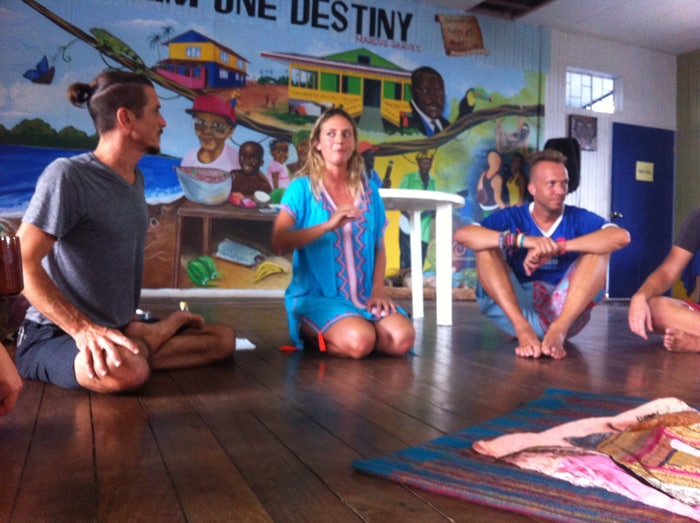
The fourth annual Chocolate Festival, in Costa Rica’s south Caribbean tourist mecca of Puerto Viejo, kicked off Friday night with a huge party at Hot Rocks, the bar in the center of town, and seemingly the whole town came. Chocolate exhibitors offered tastings of their products, free shots of a chocolate drink were handed out, gymnasts swung on silks from the ceiling and dancers gyrated to live music.
On Saturday, various workshops were held, including the “bean to bar” process of making chocolate, a chef’s presentation on virtually unknown uses for the husk of the cacao fruit, a talk on the health benefits of cacao, and tastings of chocolate and liquor that were muy delicioso.
And, of course, there was the Cacao Ceremony.
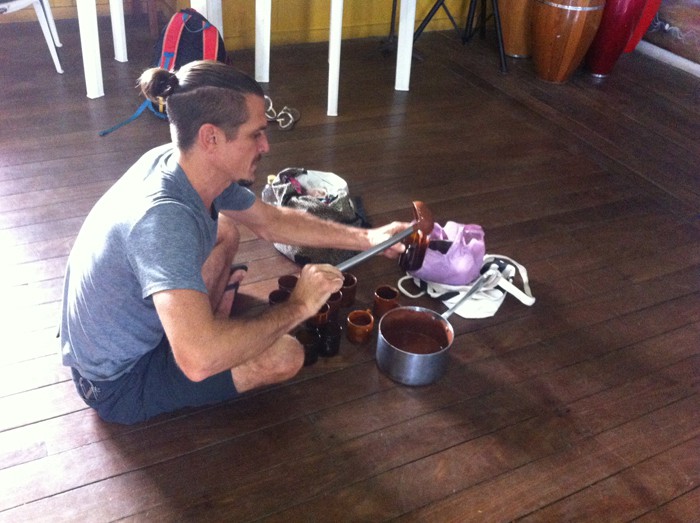
“Once you get your ceremonial drinks of cacao, just wait a minute,” Hannah said. “Take a moment to feel the heat. … Take a moment for gratitude, for giving thanks for this beautiful cacao that we’re allowed to eat, that we have this beautiful opportunity from Mother Nature. We can close our eyes and just feel this beautiful intention and perhaps decide what experience we’d like….”
The man who handed out the cups of chocolate sat in flawless lotus position, fingertips touching, eyes closed — clearly not his first ceremony. A man opposite me with the sides of his head shaved kept his eyes closed for a long time, soaking in the experience. I felt a little lost.
“You can smell the cacao, and whenever you’re ready, just take a sip,” Hannah said. “It’s really a beautiful moment to enjoy each sip … perhaps feeling the effect of the cacao going down the throat, perhaps feeling the slow effects through the body.…
“The idea is that if we begin to enjoy this experience more and more, slowing our mind down, slowing the experience down to the point of really appreciating what that means, thinking about the tree that the cacao came from, the fruit, the cacao bean, and the whole process — who picked those fruits, the whole process of fermentation and all the way up to the stage where we’re drinking it, to think about that whole journey that it took to get to our mouth.”
Wow, really, all that?
“The whole idea is if we can start to really take our time to enjoy experiences, feel grateful for where they came from, taking that sacred pause with each thing that we do and take into our body, the idea is that we become more conscious in all areas of our lives, perhaps our relationships, our bodies, our spirit, our emotions, really knowing where we’re at.”
Oh my God, I thought, have I joined a chocolate cult?
And that was before the sage “smoke bath” and the people in the circle sharing their thoughts. They gave me chocolate, and then they made me talk! But I’ll get back to that.
I started the day Saturday talking to exhibitors in Hot Rocks. Sara López of CariBeans was offering samples of chocolate chunks with milk, espresso, salt and lime, cinnamon, cardamom and nutmeg, and chai tea. Chocolate apparently goes good with everything.
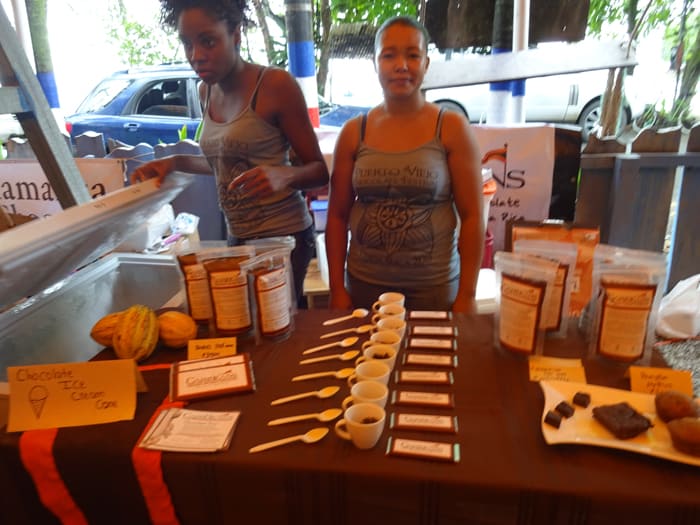
I overheard a woman from Scotland at the next booth saying, “Don’t ever let anyone tell you that you can’t have chocolate when you want.”
The Scotswoman turned out to be Ancel Mitchell of Talamanca Chocolate, now in her ninth year in Costa Rica. She and her husband have a botanical garden in Playa Negra, and they grow their own cacao and have been making chocolate for four years.
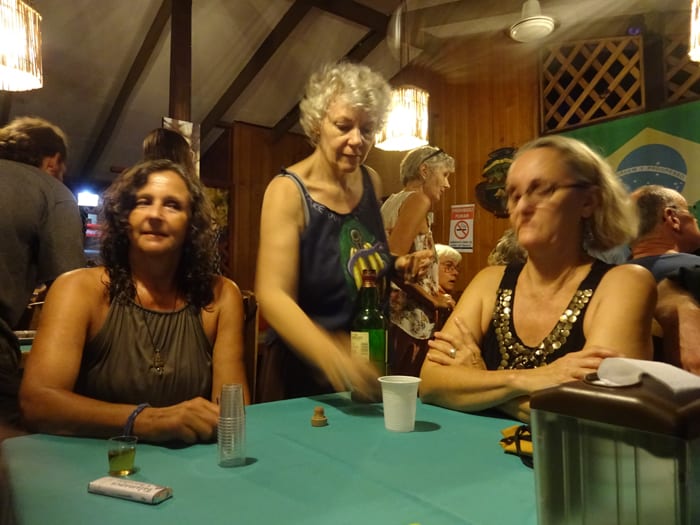
“In the high season, which here is between Christmas and Easter, we make about 300 bars a week,” she said. “But in the low season we make about 150, and we sell more or less all of them at the farmer’s market.”
She said a cacao blight in the late 1970s wiped out the local industry, and then CATIE (the Tropical Agricultural Research and Higher Education Center in Turrialba) developed a type of cacao that was resistant to the blight.
“And it is blight-resistant, but it doesn’t taste very good,” she said, “which has become a problem for the mostly indigenous farmers that bought the CATIE trees.”
“So all the chocolatiers here, and there’s seven of us now, all use heirloom cacao,” she said. “So we all use old varieties of cacao, we don’t use CATIE.”
But what about the blight?
“The blight still exists,” she said, “but all the chocolatiers here have cacao up on the hill, and so the breezes come in from the ocean and the breezes come out of the land in the evening, and so it keeps the air circulating, and the blight is a fungus, so it keeps the blight down. But we still lose a portion of the cacao to the blight every year.”
I met a Bribri woman named Viviana Salazar López who was selling pure chocolate the size of a big hamburger patty, as well as orange-flavored chocolate bars.
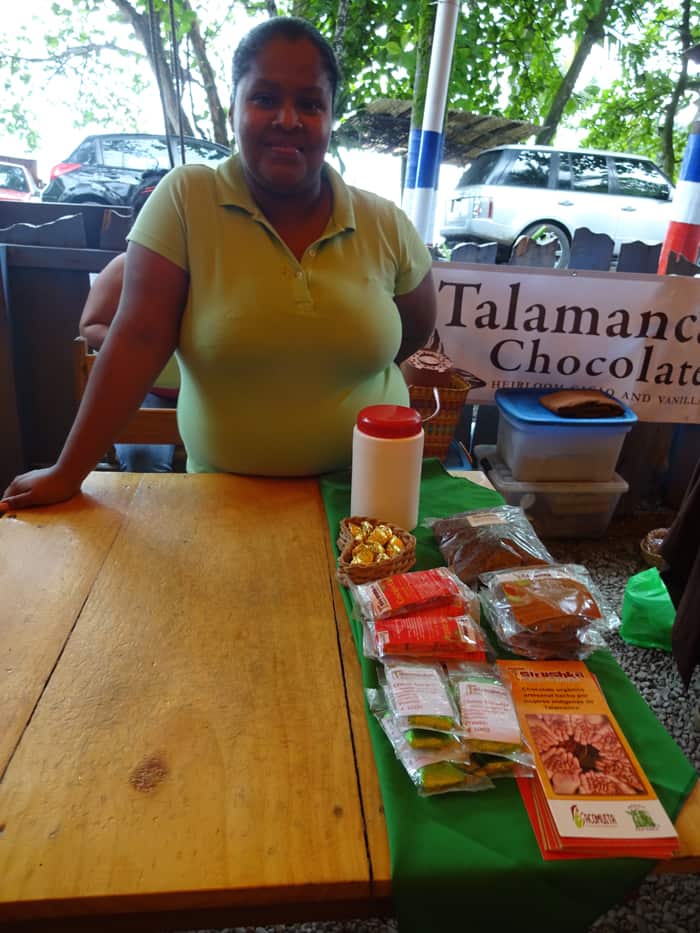
I met David Wettstein of Chocorart (chocolate orgánico artesanal, which is translated exactly like you would think), said to be the original chocolate maker in the Puerto Viejo area, now celebrating its 20th anniversary.
David was telling me how his father started this business, and then a woman walked up and asked about something and he said, “That’s 100 percent. It’s buenísimo for hot chocolate with milk and sugar, there’s nothing better.”
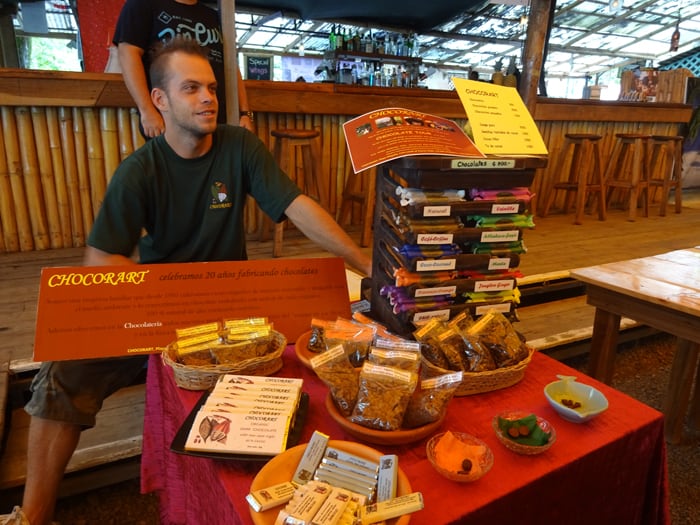
The woman turned out to be the Tica wife of a gringo friend of mine in Turrialba who teaches courses in water rescue — small world.
I wandered over to the next exhibit, where I met Yolanda López of Seville, Spain, who has a company called Namú in Cocles that makes soaps and flower water made with cacao, coconut, ylang ylang flowers, lavender and other essential oils. Her soaps smelled good enough to eat.
“For me it’s a passion, and every day I’m surprised by what Mother Earth gives us,” she said.
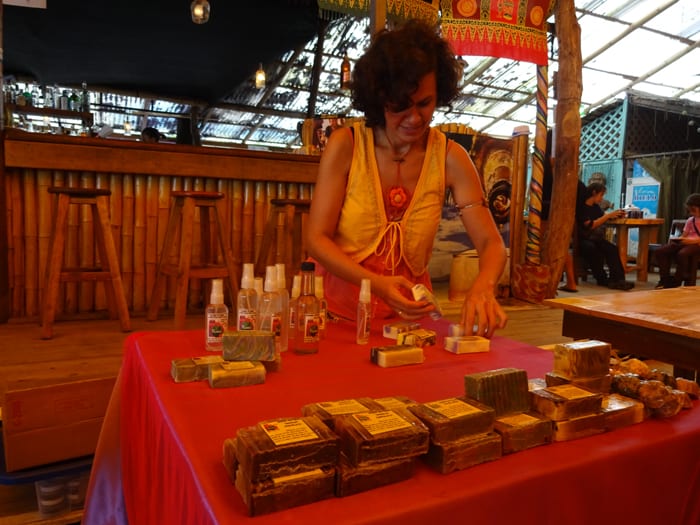
At 1 o’clock it was time for the mole cooking lesson by my Mexican friend Alejandro Corral, whom I met the night before drinking craft beer at Kaya’s Place brewed by owner J.T. Ficociello. (J.T. brews a beer called Austin’s Ale that contains local cacao and roasted coconut, and it is excelente.)
Alejandro, wearing a black chef suit and a bandanna on his sweaty forehead, explained that cacao was sacred to ancient Mesoamerican cultures, who considered it a food of the gods.
The Mayans and Aztecs ate it with peppers and drank it in an unsweetened, somewhat bitter concoction. It was not until the Spanish arrived that milk, sugar and cinnamon were added to cacao.
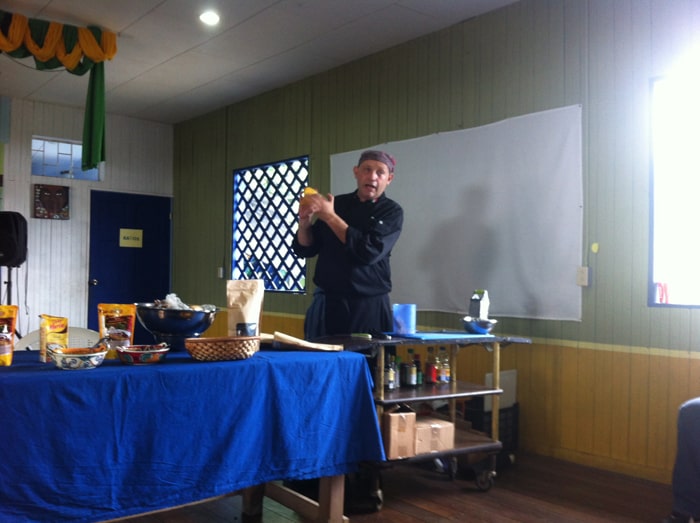
Alejandro said “moli” was the ancient word for a salsa, any kind of sauce, so when you make a sauce of aguacate (avocado), it’s called guacamole. Mole, the traditional dark Mexican sauce served with meats and enchiladas, can have up to 100 ingredients, he said, but usually has 30 to 40. Many moles contain cacao but most of them don’t, he said.
In Costa Rica it’s hard to find the chiles needed to make proper Mexican mole, Alejandro said, but he showed us several varieties you can buy in stores.
Slicing into a yellow cacao fruit, Alejandro removed the gummy white beans and passed them around for people to taste. If you ever go on a chocolate tour in Costa Rica, you will find out exactly how those are turned into sweet treats.
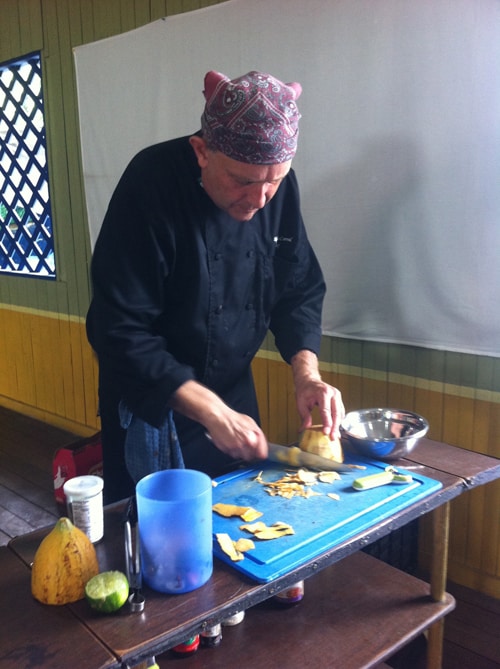
But then Alejandro showed us the husk of the empty cacao fruit, which is normally discarded to rot. He said he got bored one day and decided to experiment with the fibrous husk.
He recreated his experiments in front of us, showing us that first you have to add lime, vinegar or olive oil to keep the fruit from oxidizing and turning brown. He cut it into thin slices, added several ingredients and passed around what he called “cacao sashimi.” It tasted like Japanese fish without the fish.
Alejandro explained how he learned to dehydrate these cacao slices so they can be preserved, and maybe someday even exported. He offered samples of these dehydrated slices, nicely flavored.
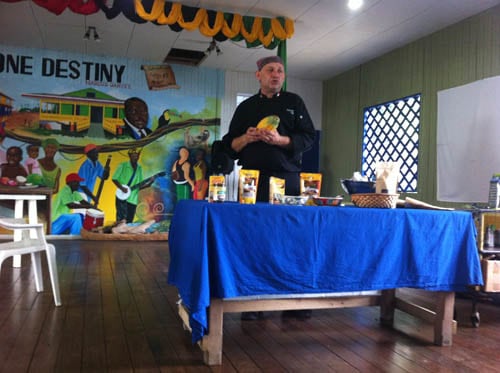
Then he made an Italian sauce with tomatoes, garlic and dehydrated cacao that tasted like marinara. He pointed out that it tasted “meaty,” saying this could be a good meat substitute for vegetarians.
It was as if Alejandro had discovered a brand-new food in what is ordinarily considered garbage. He even showed us a flour he developed, made from dried, ground cacao, that can be used for baking.
As Alejandro’s allotted hour ended, I remarked to the people next to me that it looked like he was going to make everything except mole. I teased him about this later, and he told me he asked the organizers to change the name of his presentation to say cacao and not mole, but that never happened.
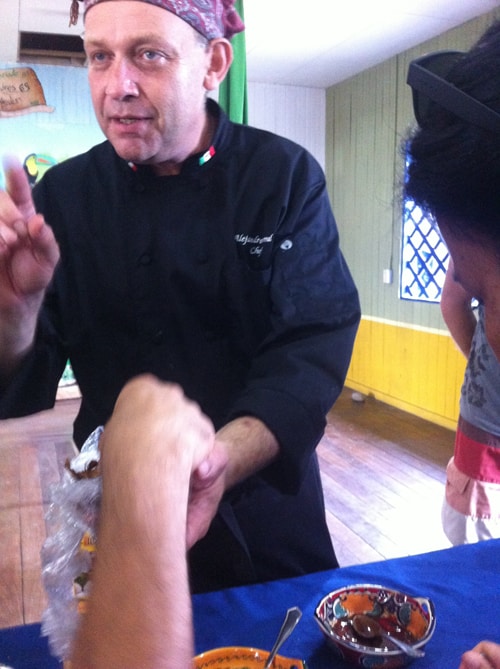
Alejandro ended with a smile, a “Ta-da!” and a bow. And then it was time for the Cacao Ceremony, where we moved from nourishing the body to enriching the spirit.
But before I finish that story, I have to fast-forward to the wine-liquor-chocolate pairings that happened Saturday night at Restaurante Tamara. (I remarked to one person, “The Chocolate Festival is like the Big Bang — it happened everywhere at once.”)
Close to 5 I was ushered upstairs into the restaurant and seated with a half-dozen English-speaking guests from all over. A local chocolatier named Peter Kring brought out samples of three kinds of chocolate (Olmec, allspice and cardamom), along with shots of Glenlivet scotch.
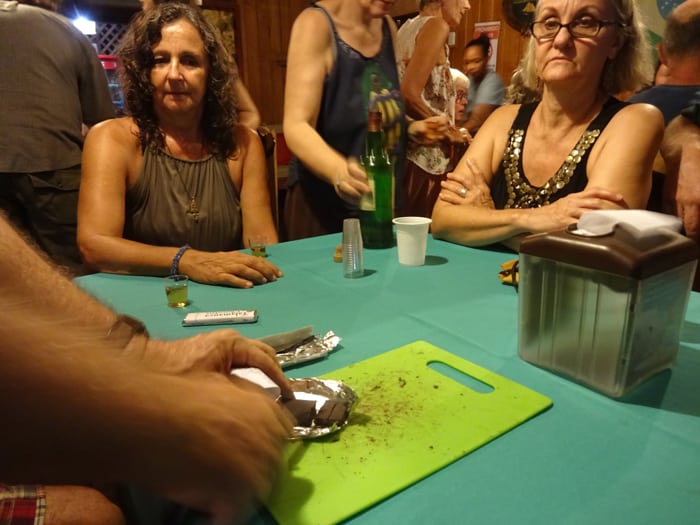
I told the Frenchman next to me, Pierre, that I was “working,” with air quotes. Covering a chocolate festival is hard work, but somebody’s got to do it.
“What we recommend with the pairings is you take one or two pieces of the chocolate, chew it, get it about half melted, and then take a bit of the whiskey and drink it into your mouth,” said Peter. “Don’t swallow it straight away, but let it melt with the whiskey, let it work around in your mouth, and then swallow them together.”
I have joined a chocolate cult, I thought, but at least it’s a cult that drinks.
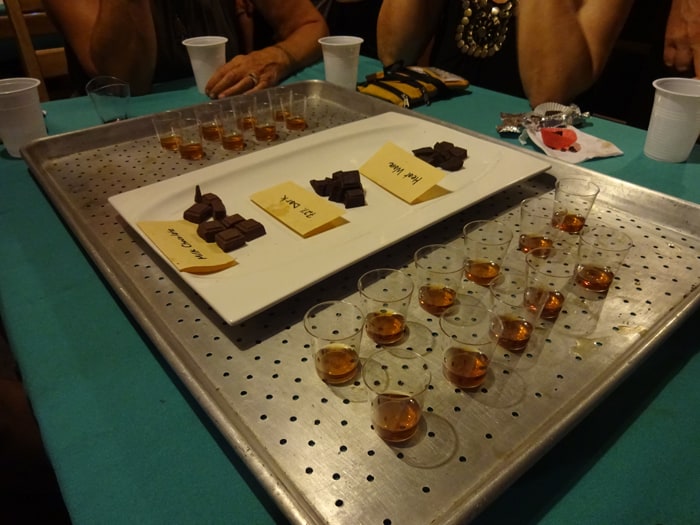
Later came shots of rum, port, Bordeaux and of course more chocolate.
“What do you think?” someone asked.
“Absolutely terrible,” I joked.
“There’s something missing,” said Pierre, without a hint of a smile. “More port.”
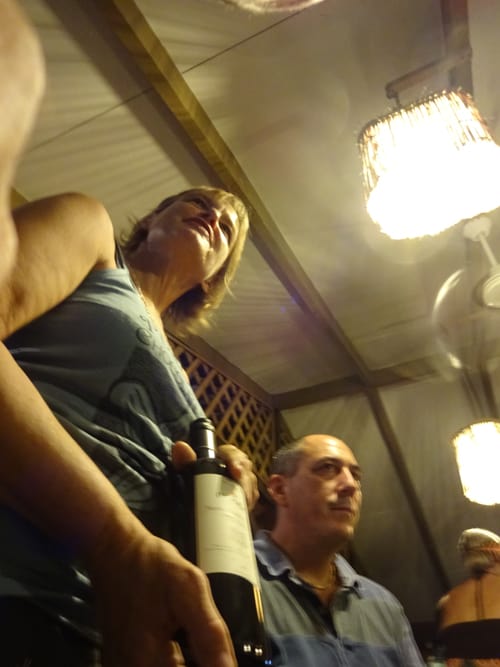
But to finish the story I have to return to the Cacao Ceremony. Hannah applied a Bic lighter to a roll of sage and explained that she would hand it around, and each person would wave the smoking sage around their head and introduce themselves and say something about how they were feeling.
She said we shouldn’t be afraid of speaking in front of a group, but I would have been more afraid if she had asked us to close our eyes again and be quiet for five minutes.
Hannah waved the sage in circles around her face and said some things about herself, then handed the sage and the lighter to her left. Everyone in turn relighted the sage and introduced themselves — all foreigners except for three Ticas from San José, who all spoke English. One said she had never been here before, confirming my suspicion that many foreigners have seen more of Costa Rica than many Costa Ricans.
The woman to my right handed me the sage and the lighter, and I reignited the sage roll.
“My name is Karl,” I said. “I came to Puerto Viejo thinking I might end up passing herbs and a lighter around in a circle, but I wasn’t expecting this.”
The group erupted in laughter.
Yes! My new cult has a sense of humor.
For more info: http://pvchocolatefestival.com
Contact Karl Kahler at kkahler@ticotimes.net.






